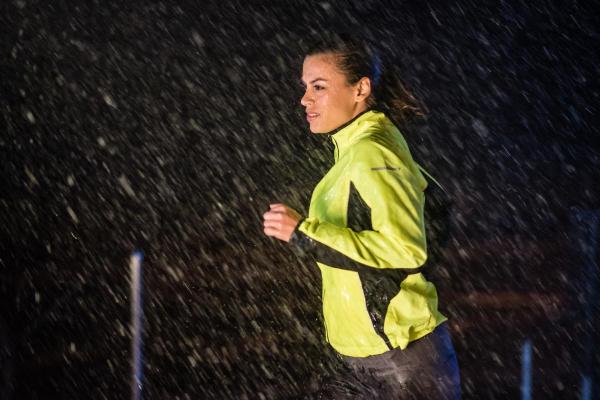How to Run in the Rain Safely


Running is a cardio workout which is designed to help keep you healthy. Just as running in the right way helps us to maintain health, doing it incorrectly can be damaging to it. Although our normal way of running can be beneficial when on dry surfaces, running in the rain can completely change the game. When a surface is wet from rainwater, it can become very slippery and increase the risk of injury from a fall. Negative effects of cold weather can also be greatly increased when it is wet. Even running in the rain in warm weather can be dangerous.
For this reason, oneHOWTO explains how to run in the rain safely. We provide 10 tips for running in the rain so you can avoid injury and ensure you stay healthy.
- Do not run during storms
- Wearing a cap for running
- Pay attention to the temperature
- Don't wear too many clothes
- Prevent chafing
- Put on the most suitable footwear
- Beware of puddles
- Protecting your electronic devices
- Taking care of your sneakers
- Take off your wet clothes quickly
Do not run during storms
Running in the rain can be a very relaxing and even liberating feeling. It can be very pleasant and even push us harder when we want to improve our stamina. If the downpour turns into a thunderstorm, these benefits are far outweighed by the risk. It is best to stay at home, at least until the storm passes and the intensity of the rain returns to normal.
It is not worth risking the possible consequences of a storm such as a hailstorm, excessively strong winds or even exposing yourself to the range of a lightning bolt. Running during a lightning storm with rain is particularly dangerous due to the high conductivity of water.

Wearing a cap for running
Running with raindrops on your face can be a great feeling, but a cap with a visor can be your best ally during any rainy workout. With a cap, you'll keep the water out of your eyes and your hair should be at least a little drier. If you wear glasses, you'll still be better able to see clearly while running by wearing a cap with a visor to keep the rain off your lenses.
Pay attention to the temperature
On rainy days, the temperature can drop several degrees. This is especially the case if you are at high altitude. In such situations, wearing an extra layer such as a waterproof jacket can be a good solution.
Only wear rain gear that is breathable, meaning it doesn't trap heat and moisture. You should also stay away from cotton as much as possible, including your socks. Cotton is a material that tends to absorb water and can increase the risk of various illnesses.
Learn more about staying healthy while running with our article on whether it is dangerous to do cardio on an empty stomach.

Don't wear too many clothes
While an extra layer can protect from the cold, overdressing is also a big mistake runners make when training in the rain. If you're feeling hot, a tank top or regular shirt may be enough. Wearing more layers won't help you stay dry. In fact, soaked clothing will weigh you down and can make you feel colder.
Prevent chafing
Friction can happen during any race, but it can be much worse if you run in the rain and become wet. If you plan to run for a long time, use topical emollients such as Vaseline on the areas of your body that tend to cause problems and are most affected by chafing. These include the nipples, feet, armpits, inner thighs or where heart rate straps and bras pinch.
Put on the most suitable footwear
If you are wondering what shoes to wear while running in the rain, generally speaking, you should use the ones with the best grip. Shoes that are too worn or too new tend to slip even on asphalt. If you don't run on roads, you should take into account the amount of rain that falls so that too much water doesn't get into your shoes and your feet get soaked.

Beware of puddles
If the rain is persistent and you are getting wetter as you run, you may start to feel like you don't care and step in a puddle. This can be dangerous and unpleasant. Running with wet feet from the rain is very different from having them soaked from stepping into a puddle.
Running with wet shoes can change the fit of the shoe itself, causing more friction and leading to damage to your feet on long runs. In addition, you have a greater risk of injury. This is because deep puddles can hide hidden holes, which can cause a fracture or sprain.
Protecting your electronic devices
Most running headphones and watches are waterproof, but not all models. This is especially so with older products. If you run with your smartphone, it's best to use waterproof cellphone armband holders. Alternatively, for once you can take advantage of the opportunity to train in freedom, running in the rain and enjoying the fresh air without carrying any electronic devices.

Taking care of your sneakers
Even though you will need to put wet clothes in the washing machine, don't make the mistake of putting your shoes in too. If your trainers are dirty, rinsing them under the tap will be enough to remove any mud and small residue.
We we recommend putting newspaper inside the shoes to absorb moisture, preserving their shape and materials. Don't put them in the dryer or put them near strong heat sources such as radiators, as this could alter their characteristics and warp them.
Take off your wet clothes quickly
When you finish running, you may feel warm even though it is pouring rain. To avoid lowering your body temperature too quickly and risking hypothermia, it is best to dry yourself off and immediately change the clothes you are wearing.
If you are at home, take off all your clothes and enjoy a well-deserved hot shower. If you are travelling by car, make sure you have dry clothes to put on immediately after running in the rain.
Now that you know some tips for running in the rain, find out more with our article on how to do hypopressive exercises.
If you want to read similar articles to How to Run in the Rain Safely, we recommend you visit our Fitness category.








